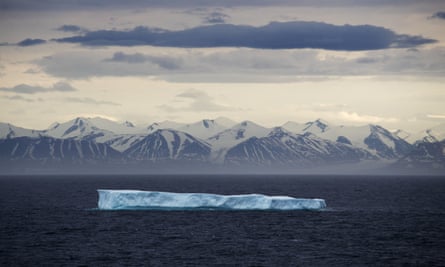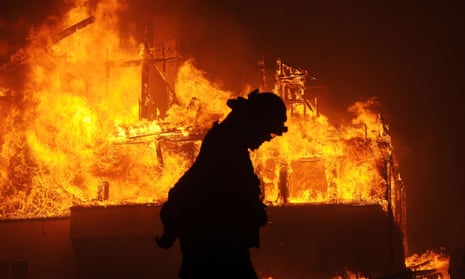Scientists say 2017 is set to be the third warmest year on record in the US as they look back on a year littered with stark signals of climate change.
The year-to-date average temperature across the contiguous US has been 2.6F above the 20th-century average, according to the National Oceanic and Atmospheric Administration (Noaa), placing it only behind 2012 and 2016 in terms of record warmth.
December may influence the overall 2017 ranking, but according to Jake Crouch, a climate scientist at Noaa: “We can say with confidence that the year will be in at least the top five,” for record warmth.
“It’s been another really warm year for the contiguous US,” Crouch said. “The last time we saw a year with below-average temperatures was 1996. So this will be the 21st consecutive year that’s above average. And even though it’s not a record, we are seeing climate change manifest itself.”
Eight states – Arizona, New Mexico, Florida, Georgia, North Carolina, South Carolina, Virginia and West Virginia – have in fact experienced record warmth for the first 11 months of the year. A national record, however, is out of reach due to the lack of an El Niño, a periodic climatic event that appeared last year and spurred extra heat.
But the fingerprint of climate change extends beyond just temperature. California’s deepest drought on record was broken by intense rainfall at the start of the year, an example of the long dry spells interrupted by ferocious downpours that scientists say are becoming more frequent in a warming world.
To the north, Arctic sea ice reached a record low wintertime maximum extent as, incredibly, temperature instruments in Alaska malfunctioned due to the surging warmth.

Further south, there was a hurricane season that was unusually punishing. There were six major hurricanes, defined as category three or above, including the first two major hurricanes – Harvey and Irma – to hit the continental US in 12 years.
“This was a hurricane season that wouldn’t quit,” said Timothy Gallaudet, acting Noaa administrator.
Quick GuideTropical storm Harvey and climate change
Show
Is there a link between the storm and climate change?
Almost certainly, according to a statement issued by the World Meteorological Organization on Tuesday. “Climate change means that when we do have an event like Harvey, the rainfall amounts are likely to be higher than they would have been otherwise,” the UN organisation’s spokeswoman Clare Nullis told a conference. Nobody is arguing that climate change caused the storm, but it is likely to have made it much worse.
How did it make it worse?
Warmer seas evaporate more quickly. Warmer air holds more water vapour. So, as temperatures rise around the world, the skies store more moisture and dump it more intensely. The US National Weather Service has had to introduce a new colour on its graphs to deal with the volume of precipitation. Harvey surpassed the previous US record for rainfall from a tropical system, as 49.2 inches was recorded at Mary’s Creek at Winding Road in Southeast Houston, at 9.20am on Tuesday.
Is this speculation or science?
There is a proven link – known as the Clausius-Clapeyron equation – that shows that for every half a degree celsius in warming, there is about a 3% increase in atmospheric moisture content. This was a factor in Texas. The surface temperature in the Gulf of Mexico is currently more than half a degree celsius higher than the recent late summer average, which is in turn more than half a degree higher than 30 years ago, according to Michael Mannof Penn State University. As a result there was more potential for a deluge.
Are there other links between Harvey and climate change?
Yes, the storm surge was greater because sea levels have risen 20cm as a result of more than 100 years of human-related global warming. This has melted glaciers and thermally expanded the volume of seawater.
While these hurricanes may well have formed without human-induced warming, the extra heat in the Atlantic and in the atmosphere helped fuel the storms. Harvey, which dumped around 25tn gallons of water on the Houston area in just a few days, derived perhaps a third of its strength from the extra heat added to the planet since industrialization, according to one estimate.
“The number of hurricanes wasn’t related to climate change, that was bad luck, but the hurricanes were different because of climate change,” said Andrew Dessler, a climate scientist at Texas A&M University.
“It’s very reasonable to assume that Harvey was made worse by climate change. Maria and Irma were consistent with the idea that the most powerful hurricanes will get more powerful. This is the kind of stuff we will have to get used to.”
Ultimately, 2017 may well be remembered more for the political response to climate change. The newly installed Trump administration set about tearing up policies designed to address global warming, such as Barack Obama’s Clean Power Plan, announced the US was to withdraw from the Paris climate accord and repeatedly questioned the scientific basis of climate change.
Meanwhile, specific regulations curbing planet-warming gases from vehicles and drilling operations were scaled back, with more federal land and water opened up for fossil fuel exploration.

“The US is moving backwards as far as rational climate policy goes and I guess we will have to see whether this is a blip or a long-term trend,” said Dessler. “A lot will depend on the elections next year and whoever the president is in 2020.
“Everyone recognizes that the weather is weird and things are getting warmer, but climate change has become an identity issue. If you see yourself as a good Republican, you don’t believe in climate change. It’s hard to change that viewpoint when it’s part of someone’s identity. It’s like trying to convince someone they should be Jewish rather than Catholic.”
As for 2018, as the Environmental Protection Agency holds a sort of show trial, perhaps televised, of climate science itself, the planet will continue to warm.
“My expectation is that it will be another hot year,” said Dessler. “The climate of the past has gone. This is our new normal. I doubt we’ll ever see a record cold year again.”
